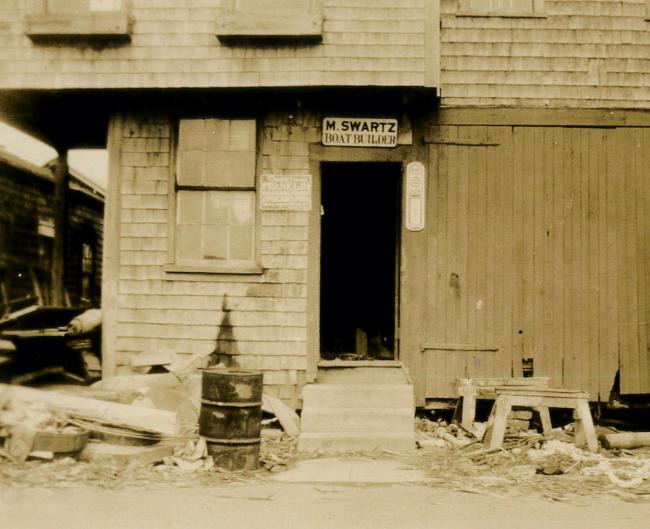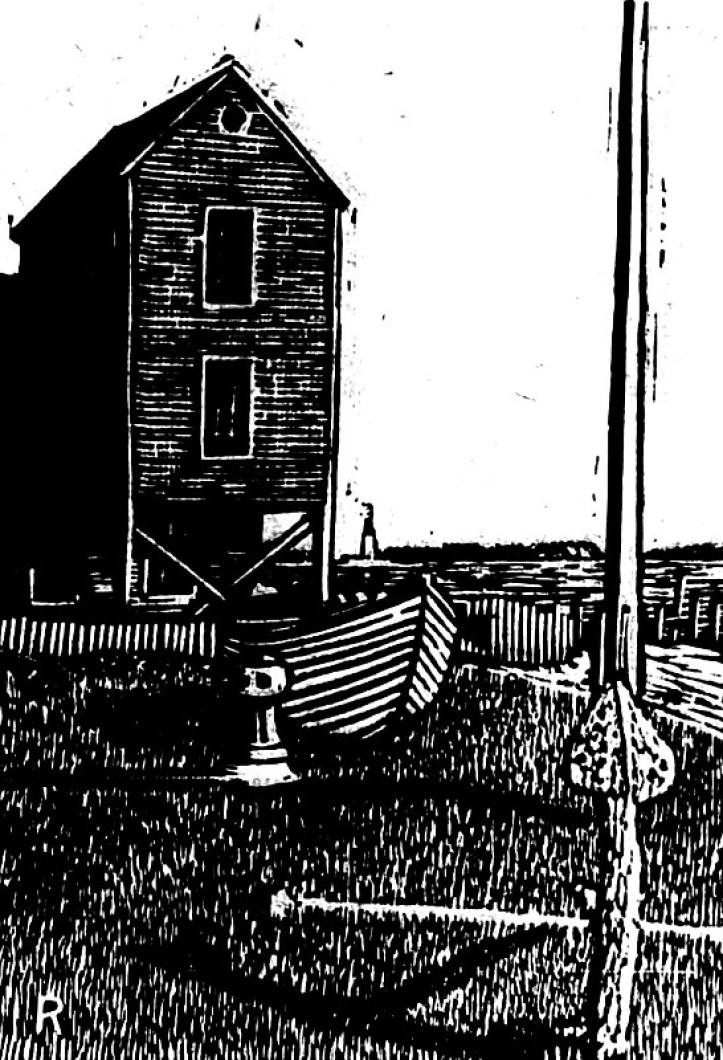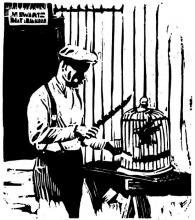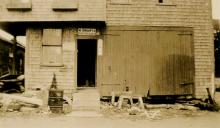When in Edgartown, we invite you to take a walk along Dock street to the northern end. There beside you is a tall grey building. Look up and up and see how it reaches into the sky with cathedral dignity. It has a tower on the front, as does any proper cathedral, and also many windows on the long sides. Farther up are rows of skylights like the clerestory in a Gothic medieval church, but our skylights leak. High in the peaks are two round windows, the glass pink with age, so it boasts two rose windows as well. These windows are special, because they are portholes salvaged from the Mertie B. Crowley wrecked off Chappaquiddick in 1910.
Although you see a sign, “Martha’s Vineyard Art Association,” painted on grey driftwood near the steps and another sign cut in the shape of a spiny, strange fish with the words “Old Sculpin Gallery” high on the side, the building has not changed much since the late Manual S. Roberts built boats there.
One of the Oldest
Manuel said that the Old Sculpin Gallery building was about 200 years old and that makes it one of the oldest on the Island. Hundreds of feet have walked up those worn steps into the cavernous interior to help or watch Manuel build his boats. Come on in.
There was a work bench the whole length of the south side, floorboards beneath worn in a deep grove. Those floorboards are still there unchanged. They are four inches think and of varying widths, some 24 inches wide, and there is a triple layer, one floor over another. No wonder hurricanes and high water have beaten against the Old Sculpin in vain. Notice that the upper floor is held up not by posts but by a second set of beam braces morticed into the regular beams at an angle, their strength increased by heavy turn buckles, to give space for boat building.
Let’s go back in memory for a moment, and quote lines from Joseph C. Allen:
And always in those pictures which in memory appear,
Of catboats on the blockings and the deck piled high with gear,
With planks and knees and timber and with shavings in a pile,
Is Manuel presiding with his friendly smile.
His friends called Manuel The Old Sculpin as a term of endearment, and so it was used later as a fitting title for the gallery of the Martha’s Vineyard Art Association, which took over the building in 1954.
Sawdust and Curly Shavings
If you had come inside with some of us artists then, you would have ploughed through knee high piles of sawdust and curly shavings to the back of the shop where stood a steam boiler for shaping planks, and for warmth. There were pipes running up to both of the tower rooms in case Manuel needed to bunk there to keep watch overnight, or the family wanted to spend breezy summer days there.
How did one get up there? By perpendicular ladder of course. The ladder has since been replaced by a broad, heavy, old stairway, procured for us by Capt. Sam Norton, who was always interested in our doings.
Let’s go back to another moment and consider the fact that this large building was once down on the main dock. The dock was called Dr. Fisher’s Wharf. Dr. Daniel Fisher had an oil factory near where the Old Sculpin now stand. Later he had The Old Sculpin building moved to its present location when he was engaging in the grain business, and he used it as a grain store and shipping station. The grain chutes may still be seen poking through the ceiling from the upper floor.
After Dr. Fisher’s death, David Barney, the Norton brothers, Lorenzo Fisher, Charles Worthington Pease and Charles Vincent were associated with the building. Manuel bought it in 1904. He had been building boats before that, so when 1954 arrived, he said, “I have built boats for 53 years and now I am run out.” It was his desire that the Art Association buy the building. Until his death he spent many happy days presiding in our doorway.
From Boat Shop to Gallery
The Martha’s Vineyard Art Association became a corporation in February of 1954. Mrs. Ruth Vietor, and Virginia Berresford, then vice president, were authorized by our treasurer, Mrs. Caroline E. G. Tuthill, to sign the agreement to buy the boat shop. An initial payment was made then. The transition from boat shop to gallery had to be made before the summer of 1955 and there was much to be done in moving and much expense involved in general cleaning up, in putting in new window frames, replacing leaky skylights, worn out shingles, installing plumbing and getting proper units for exhibiting paintings and sculpture.
The units we now have for paintings are called “pogo boards” because they have pogo-like feet at the bottom and spring joint units at top, so that they can easily be pushed up against the rafters singly or in rows. Units of this identical type are used in the modern additions at the Yale School of Art and Architecture. They kindly gave us the specifications. Mrs. Goodwin made a special trip to procure this information.
How did the association get money to finance all this? In several ways. First the artists donated paintings which were auctioned by the beloved painter, Julius Delbos. Money received, $1,400, went to the purchase fund. Another project which helped raise the fund was a benefit movie, the remarkable Conquest of Everest. Then too, many friends of artists as well as lovers of the old boat shop donated gallantly to the double cause of preservation of the old building and more adequate space for the art Association gallery.
Began Back in 1934
The history of the association goes back to 1934 when a group of painters worked together and exhibited at what is now the Sally Wren Shop. The original group included Douglas Prizer, Harwood Steiger, Ruth Mead, Mildred Ridgely, Evangeline Cozzens and Mrs. Goodwin. Other artists joined from year to year, including Russell C. Veit, Eleanor Hoxie, Amy Ferris, Lillian Cotton, Jean Spencer, Mr. Delbos and others. Miss Helen Sandord was our gallery director then for many years. With the 1938 hurricane we moved to the Coffin House while repairs were made.
For two years a gallery was maintained in the John Coffin House on North Water street, and after that in the remodelled Dock street building which is now the Sally Wren. The Association soon outgrew this.
In 1954, after taking over the Old Sculpin, the increased space made it possible to hold classes upstairs, to rent gallery space for several one-man shows at once, as well as gallery room for active members.
Three years ago, a substantial gift in memory of Francis Chapin was put into a scholarship fund. Additions to that found have been given in memory of Mrs. Tuthill and recently in memory of Mrs. Hoxie. Further additions were made from time to time, proceeds from lectures and other fund-raising event. Thus we were able last summer to present a first substantial scholarship to a Vineyard college student.
Aims of the Association
At its first meeting, the association announced that it was incorporated for the benefit of the community in these respects: to increase facilities for art education, to create interest in the arts, to foster appreciation of them, to make an art center for the whole Island, to establish a permanent collection and to preserve an old landmark.
The officers at the time were Mrs. Summer A. Mead, president; Mrs. Tuthill, treasurer, and Mrs. Goodwin, secretary. Directors were Miss Amy Ferris, Mrs. Tuthill particularly labored many hours to establish the fiscal status of the association, according to the requirements of the U.S. Treasury Department.
Various members were created, from Active to Sustaining, with riles and regulations for each. Many lectures, movies and demonstrations free to members and at a small charge to others have been given during the years. Originally the upstairs classroom was used for these lectures, but now since we have outgrown this we have been able to use the parish house of the Edgartown Federated Church on South Summer street.
Painting Demonstrations
As early as July 1955, the association gave a series of painting demonstrations. The making of a block print from cutting to inking and pressing was competently shown by William Abbe; Francis Chapin gave an excitingly colorful demonstration in watercolor; Evangeline Cozzens painted a witty watercolor; Evangeline Cozzens painted a witty watercolor of busty gulls in a stiff row on the yacht club ridge pole, their forms duplicated in bust ladies on the boat tender approaching the yacht club ramp; Gilberta Goodwin made a rough sketch in oil.
On another day, Clay Bartlett made a Chinese ink wash drawing. This work ended with a demonstration of portraiture by two distinguished artists, Lillian Cotton and Jean Spencer, both painting from the same model and both using totally different techniques.
In a later summer, members and friends were regaled with demonstrations by Max Kahn, Eleanor Coen and Tom Maley all painting from models, their techniques fascinatingly individual. Another treat was a musical evening with Gale and Mildred Huntington singing songs the whalemen sang, to a guitar accompaniment. William Lydgate gave us a delightful evening of classical guitar music. Vance Packard discussed some of his books with John Tebbel, followed by a lively question and answer period. Ann Wallin gave a colored-slide lecture on Vineyard flora and fauna, a high spot of breathtaking beauty.
Particularly “Minimal Art”
During the latter part of the 1968 summer, one evening a week was devoted to various entertainments at the parish house. First was the colorslide talk on a trip on middle Asia and Russia by Mrs. Marianne Harper. Since these photographs were taken by her on a trip through these areas, they were outstanding. Next, Mrs. Adelyn Breskin, curator of Modern Art at the Smithsonian Institution, graciously agreed to give us a slide talk on Art in Our Time. Some of these new forms were hard to take, particularly “minimal art,” so there were many questions from the floor. This was indeed an exciting evening.
This coming summer we expect to do more of this sort of thing, interspersed with demonstrations in styles and techniques by well known artists.
Last summer, one evening a week there were free “paint ins” at Old Sculpin. Anyone bringing his own materials could use the easels and tables in the classroom, paint from a model or still life or use his own psychedelic fancies. This was very popular.
Daytime teaching at the Old Sculpin includes children’s and adult classes, studio and outdoor painting. There are two studios which are rented and spoken for well in advance. These have windows on three sides with wide views of the harbor and waterfront activities.
So it is that an old landmark has been kept intact while blossoming into an art center which all may enjoy, a proper metamorphosis from the previous creative activity of Manuel’s boat building.
We are still under the competent and stimulating direction of our beloved president, Ruth Appeldoorn Mead, in this our 15th year at the Old Sculpin but our 34th year of existence.











Comments